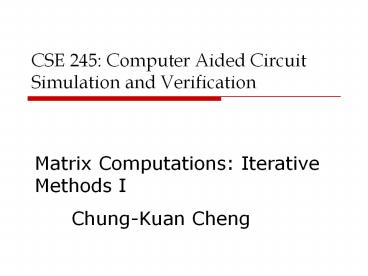CSE 245: Computer Aided Circuit Simulation and Verification - PowerPoint PPT Presentation
Title:
CSE 245: Computer Aided Circuit Simulation and Verification
Description:
... Simulation and Verification ... Proof: Given r and eigenvector V s.t. AV=rV. Let vi = vj for all j=!i, we have. sumj aijvj = rvi ... Linear Equation: MX=b ... – PowerPoint PPT presentation
Number of Views:43
Avg rating:3.0/5.0
Title: CSE 245: Computer Aided Circuit Simulation and Verification
1
CSE 245 Computer Aided Circuit Simulation and
Verification
Matrix Computations Iterative Methods
I Chung-Kuan Cheng
2
Outline
- Introduction
- Direct Methods
- Iterative Methods
- Formulations
- Projection Methods
- Krylov Space Methods
- Preconditioned Iterations
- Multigrid Methods
- Domain Decomposition Methods
3
Introduction
Iterative Methods
Direct Method LU Decomposition
Domain Decomposition
General and Robust but can be complicated if Ngt
1M
Preconditioning
Conjugate Gradient GMRES
Jacobi Gauss-Seidel
Multigrid
Excellent choice for SPD matrices Remain an art
for arbitrary matrices
4
Introduction Matrix Condition
Axb With errors, we have (AeE)x(e)bed Thus,
the deviation is x(e)-xe(AeE)-1(d-Ex) x(e)-x/
x lt eA-1(d/xE)O(e)
lt eAA-1(d/bE/A)O(e) We define the
matrix condition as K(A)AA-1, i.e.
x(e)-x/xltK(A)(ed/beE/A)
5
Introduction Gershgorin Circle Theorem
For all eigenvalues r of matrix A, there exists
an i such that r-aiilt sumi!j aij Proof
Given r and eigenvector V s.t. AVrV Let vigt vj
for all j!i, we have sumj aijvj rvi Thus
(r-aii)vi sumj!i aijvj r-aii(sumj!i aij
vj)/vi Therefore r-aiilt sumj!i aij Note if
equality holds then for all i, vi are equal.
6
Iterative Methods
- Stationary
- x(k1) Gx(k)c
- where G and c do not depend on iteration count
(k) - Non Stationary
- x(k1) x(k)akp(k)
- where computation involves information that
change at each iteration
7
Stationary Jacobi Method
- In the i-th equation solve for the value of xi
while assuming the other entries of x remain
fixed - In matrix terms the method becomes
- where D, -L and -U represent the diagonal, the
strictly lower-trg and strictly upper-trg parts
of M - MD-L-U
8
Stationary-Gause-Seidel
- Like Jacobi, but now assume that previously
computed results are used as soon as they are
available - In matrix terms the method becomes
- where D, -L and -U represent the diagonal, the
strictly lower-trg and strictly upper-trg parts
of M - MD-L-U
9
Stationary Successive Overrelaxation (SOR)
- Devised by extrapolation applied to Gauss-Seidel
in the form of weighted average - In matrix terms the method becomes
- where D, -L and -U represent the diagonal, the
strictly lower-trg and strictly upper-trg parts
of M - MD-L-U
10
SOR
- Choose w to accelerate the convergence
- W 1 Jacobi / Gauss-Seidel
- 2gtWgt1 Over-Relaxation
- W lt 1 Under-Relaxation
11
Convergence of Stationary Method
- Linear Equation MXb
- A sufficient condition for convergence of the
solution(GS,Jacob) is that the matrix M is
diagonally dominant. - If M is symmetric positive definite, SOR
converges for any w (0ltwlt2) - A necessary and sufficient condition for the
convergence is the magnitude of the largest
eigenvalue of the matrix G is smaller than 1 - Jacobi
- Gauss-Seidel
- SOR
12
Convergence of Gauss-Seidel
- Eigenvalues of G(D-L)-1LT is inside a unit
circle - Proof
- G1D1/2GD-1/2(I-L1)-1L1T, L1D-1/2LD-1/2
- Let G1xrx we have
- L1Txr(I-L1)x
- xL1Txr(1-xTL1x)
- yr(1-y)
- r y/(1-y), rlt 1 iff Re(y) lt ½.
- Since AD-L-LT is PD, D-1/2AD-1/2 is PD,
- 1-2xTL1x gt 0 or 1-2ygt 0, i.e. ylt ½.
13
Linear Equation an optimization problem
- Quadratic function of vector x
- Matrix A is positive-definite, if
for any nonzero vector x - If A is symmetric, positive-definite, f(x) is
minimized by the solution
14
Linear Equation an optimization problem
- Quadratic function
- Derivative
- If A is symmetric
- If A is positive-definite
- is minimized by setting to 0
15
For symmetric positive definite matrix A
16
Gradient of quadratic form
The points in the direction of steepest increase
of f(x)
17
Symmetric Positive-Definite Matrix A
- If A is symmetric positive definite
- P is the arbitrary point
- X is the solution point
since
We have,
If p ! x
18
If A is not positive definite
- Positive definite matrix b) negative-definite
matrix - c) Singular matrix d) positive
indefinite matrix
19
Non-stationary Iterative Method
- State from initial guess x0, adjust it until
close enough to the exact solution - How to choose direction and step size?
i0,1,2,3,
Adjustment Direction
Step Size
20
Steepest Descent Method (1)
- Choose the direction in which f decrease most
quickly the direction opposite of - Which is also the direction of residue
21
Steepest Descent Method (2)
- How to choose step size ?
- Line Search
- should minimize f, along the direction of
, which means
Orthogonal
22
Steepest Descent Algorithm
Given x0, iterate until residue is smaller than
error tolerance
23
Steepest Descent Method example
- Starting at (-2,-2) take the
- direction of steepest descent of f
- b) Find the point on the intersec-
- tion of these two surfaces that
- minimize f
- c) Intersection of surfaces.
- d) The gradient at the bottommost
- point is orthogonal to the gradient
- of the previous step
24
Iterations of Steepest Descent Method
25
Convergence of Steepest Descent-1
let
Eigenvector
EigenValue
j1,2,,n
Energy norm
26
Convergence of Steepest Descent-2
27
Convergence Study (n2)
assume
let
Spectral condition number
let
28
Plot of w
29
Case Study
30
Bound of Convergence
It can be proved that it is also valid for ngt2,
where































